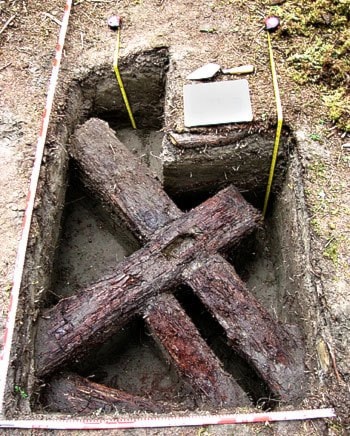The journals of Hudson Bay Company clerk and early Yukon pioneer Robert Campbell make for good reading although it can get a bit monotonous at times.
It’s all “dreadfully cold” this and “starving and sickness” that.
But then, near the end, there’s a long and gripping passage, written on Sunday, August 22, 1852, which begins like this:
“Since last date we had a narrow escape of being cut to pieces, the alternative has been the loss of our all.”
What follows is a harrowing account of the siege of Fort Selkirk by Chilkat Tlingit warriors.
Other than Campbell’s dog, Tiger, who died valiantly trying to save his master, no one was killed that day.
All the residents of the fort ended up fleeing by boat, most in whatever they were wearing at the time of the attack, with only two furs to share and no food to speak of.
This is just one example of how Campbell’s trading post misadventures run counter to the stereotypes most experts have about first contact, said historical archeologist Victoria Castillo, who recently defended her PhD thesis on work she’s done at Fort Selkirk.
The standard story goes that whenever the Hudson Bay Company moved into an area, the local indigenous people were immediately consumed.
Castillo’s research shows that was not always the case.
At Fort Selkirk, the Northern Tutchone, Campbell’s biggest trading partner, were very much in control.
Campbell writes about the natives withholding meat from the starving trading post.
And the Northern Tutchone would often save their best goods for their traditional trading partners, the coastal Chilkat Tlingit.
It was the Chilkats who evicted Campbell in the end, but he was disliked by both native groups.
“The trading post could have upset hierarchies within the Northern Tutchone system,” said Castillo.
“Rather than having your chiefs coming in to trade, a poor person could come in to trade. Campbell was desperate, so he’d trade with anybody. And he wouldn’t just trade artifacts or material culture, he would trade meat.
“Really one of the biggest things you see in the journals is that Campbell was basically starving the entire time they’re there.”
Using both archeological excavations and historical documents like Campbell’s journal, Castillo is trying to create a more complete picture of what life was like at Fort Selkirk in the 1850s.
Castillo began the excavation work in 2005, at the site she calls Fort Selkirk 2.
This is the site that everyone thinks about when they hear “Fort Selkirk.”
It’s reachable only by boat, on the far side of the Yukon River, near its confluence with the Pelly River.
Campbell’s fort was burned down after the Chilkats evicted him, although it’s unclear whether this was done by the Chilkats or the Northern Tutchone, looking to snag the fort’s iron works.
The restored buildings at the historic site today were rebuilt about 40 years after Campbell was booted out. The little community was abandoned in the 1950s after the Klondike Highway was built and Yukon River traffic died down.
The trading post’s original location, Fort Selkirk 1, was on the Pelly River.
This is where Castillo made her most interesting finds.
Because of Campbell’s journals, it had always been known that there were two Fort Selkirk sites.
But it was unclear exactly where the first fort was built, and how big it was.
When Campbell started the trading post in 1848, he accidentally built it on a flood plain.
Every spring, the area would flood, which destroyed most of the trading post’s supplies.
That was kind of a big deal, considering that replacement supplies had to come all the way from Fort Simpson, about 1,800 kilometres away.
In 1851, Campbell finally decided to pick up and move to the second location across the river.
The original site wasn’t rediscovered until 1980.
The excavation project was left sitting on government shelves for 25 years, waiting for the right PhD candidate to come along.
Castillo and her 10-person crew, which included members of the Selkirk First Nation, spent two summers doing archeological work at the original site.
She discovered that the trading post really wasn’t as big as most people thought.
Government historians had guessed that there were about 30 people at the trading post. Castillo believes it was closer to 20.
Because most of the fort had been moved to a second site, her team was only about to find the foundation of one building and few chimneys.
One exciting find was of a structure that appears to have been a large meat cellar, with wooden walls and floor.
“The preservation was phenomenal because of the flooding,” said Castillo.
“Every time it would gently flood, you’d get a layer of sediment and silts. And that preserved all the wood on the ground.”
Castillo also wanted to see if she could find evidence of women at the trading post.
There were often Metis and indigenous women from other areas in sites like Fort Selkirk. But these women are very rarely mentioned in Campbell’s journals.
Castillo discovered orders for fancy ribbons, small shoes and scissors, which all point to a small female contingent at trading post.
She also found four long bone scrapers inside or near the site.
These tools were used in processing hides, which was usually women’s work.
The team also found over 29,000 tiny pieces of crushed bone in a giant midden, just beside the main building.
The bones were likely boiled for their marrow, when the fort ran out of meat.
So Campbell wasn’t just whining when he said they were starving.
If you’d like to learn more about Campbell’s misadventures, transcriptions of his journals are available from the Yukon government’s heritage branch.
Contact Chris Oke at
chriso@yukon-news.com
